bone conduction
Latest

Shokz debuts its OpenSwim Pro waterproof bone conduction headphones at CES 2024
Shokz announces the OpenSwim Pro multi-sport bone conduction headset at CES 2024 with Bluetooth 5.3 and 32GB of onboard audio storage.
Jon Turi01.08.2024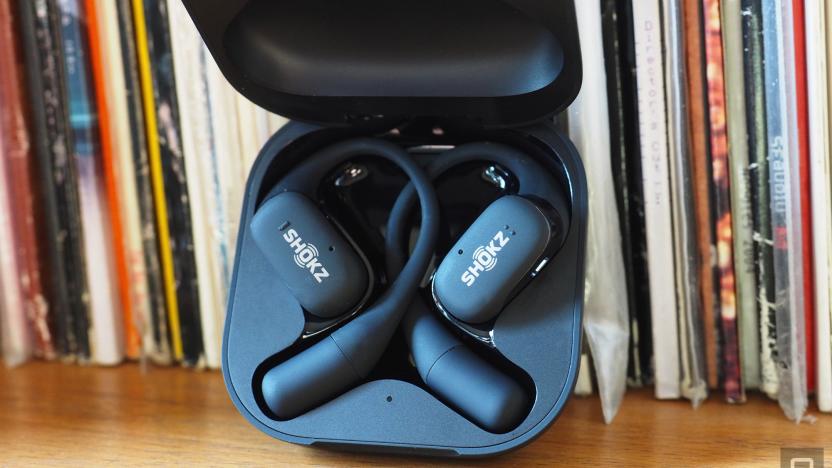
Shokz OpenFit delivers open-ear audio without bone conduction
Shokz announces the OpenFit ($179.95), its newest headphone with an open-ear design that isn't bone conduction.
Jon Turi06.28.2023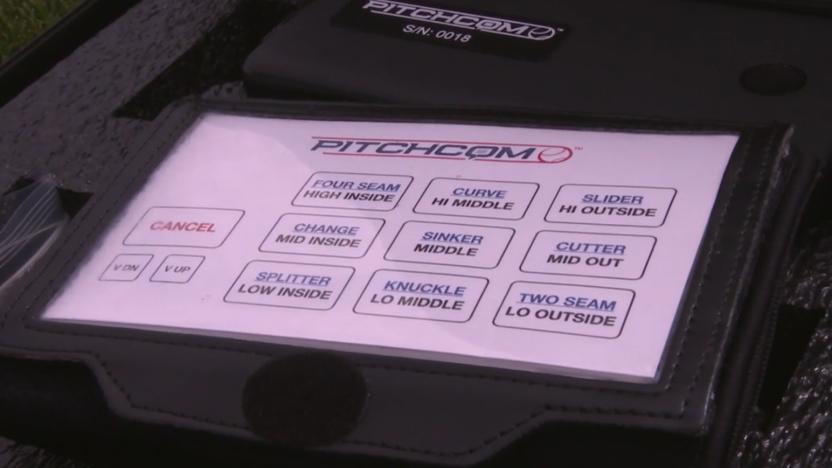
MLB is turning to an electronic pitch-calling system to fight cheating
PitchCom could prevent opposing teams from stealing signs.
Kris Holt04.06.2022
Shokz OpenRun Pro bone conduction headphones bump up the bass
Shokz, formerly known as Aftershokz, launches its new OpenRun Pro bone-conduction headphones that deliver more low-end than ever before.
Jon Turi01.04.2022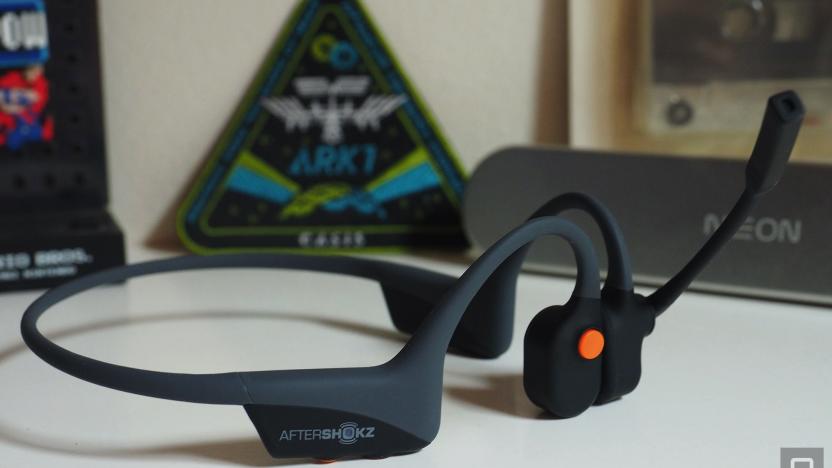
AfterShokz OpenComm is a bone conduction headset for the Zoom generation
AfterShokz’s OpenComm bone conduction headset seems an ideal accompaniment to the world we live in today. It's a communications-focused product by virtue of its boom mic, good for today’s busy home or mobile workspace in the age of endless Zoom calls.
Jon Turi10.27.2020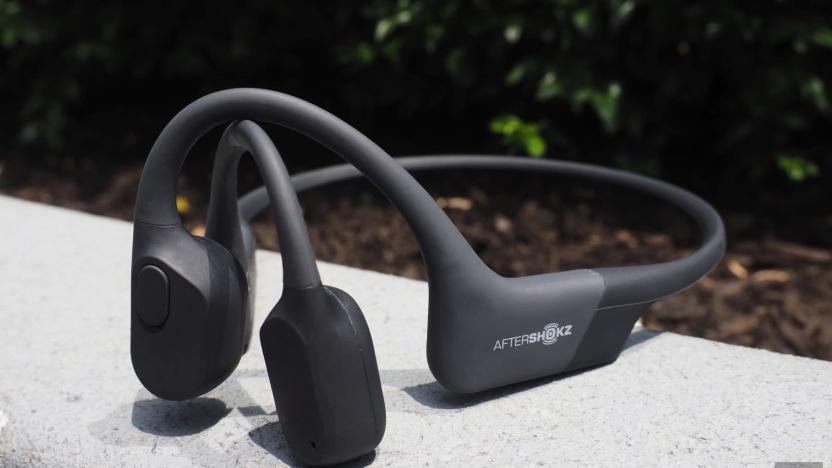
AfterShokz Aeropex open-ear headphones prove less can be more
I've been using AfterShokz bone conduction headphones ever since I reviewed them in 2015 and they've become an inseparable part of my bike rides. The open-ear design allows me to pump up my soundtrack, while still being able to hear traffic and other goings on around me. Improvements have come incrementally with a few notable leaps, but the new AfterShokz Aeropex model seems to be the culmination of the past years' developments. It's lighter than the previous Air model (Trekz being dropped from the product name), with better sound and improved waterproofing which should keep them from being susceptible to repeated outpourings of sweat. The new AfterShokz Aeropex is available starting today for $159.95. I've had the chance to use them for the past couple of weeks, so I can provide some perspective on how this new model works, especially in comparison to previous versions.
Jon Turi07.23.2019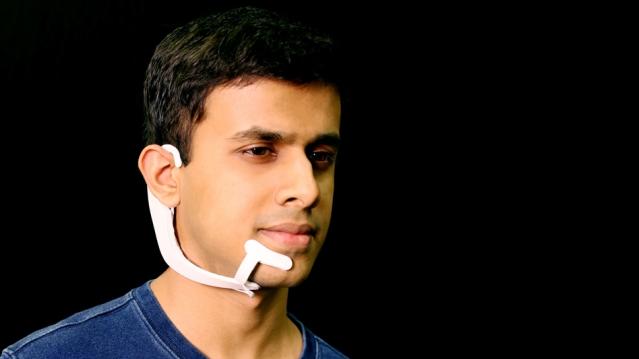
MIT's wearable device can 'hear' the words you say in your head
If you've read any sort of science fiction, it's likely you've heard about subvocalization, the practice of silently saying words in your head. It's common when we read (though it does slow you down), but it's only recently begun to be used as a way to interact with our computers and mobile devices. To that end, MIT researchers have created a device you wear on your face that can measure neuromuscular signals that get triggered when you subvocalize.
Rob LeFebvre04.06.2018
Aftershokz adds a titanium twist to its bone-conducting headphones
Like many companies these days, Aftershokz just launched an Indiegogo campaign to support its latest offering, a set of bone conduction headphones called Trekz Titanium. If you're unfamiliar with the tech, it works by sending audio as vibrations through the cheekbone to the inner ear, bypassing the ear drum. Having wireless headphones that don't block your ears is especially useful for activities like biking, where situational awareness is key, but you still want to enjoy some tunes. These are the newest in the company's line and come right on the heels of an announced update for the existing $100 Bluez2 model with audio-enhancing PremiumPitch+ technology. The Trekz Titanium offer a nearly identical feature set including Bluetooth, hands-free calls, IP55 dust/sweat resistance and a six-hour listening time. However, the rigid plastic of the Bluez2 was traded for a more flexible exterior with a titanium frame inside making them more resilient and easier to pack away. Many of the early-bird deals have already sold out, but if you're quick, you can pre-order a set for $99 or reserve a special edition pack for the full price of $129. Otherwise, you'll have to wait for the retail release in January 2016.
Jon Turi08.18.2015
Panasonic announces bone conduction headphones, we go temples-on
This year, Panasonic's pretty much gone all out with a vast range of gadgets. Tablets, TVs, Touch Pens, cameras, and outrageous Hi-Fi. One smaller addition to the company's portfolio was a pair of bone conducting Bluetooth headphones. The technology isn't exactly new, but as more and more companies get onboard, they start edging their way into the mainstream. Panasonic's take on them looks -- at least initially -- like a good start. At first, the design looks almost like any other wrap-around pair of sports headphones. Until, of course, you inspect closer, and realise that there aren't actually any buds to place in your ears. The soft-touch outer material around the ear-hooks makes them feel nice in the hand, and adds to the sporty look. Unusually they are powered by a single AAA battery, that you sneak into the slightly bulbous section in the middle of the band. We were told, however, that this might change to a rechargeable solution when we get closer to the projected fall release window. We were eager to see how the audio performed, but it's fair to say that on a rowdy show floor this was pretty difficult. We were advised to put our fingers in our ears to initially hear the music, and then remove them while focusing on the music. In reality, even with ears fully plugged, hearing the demo song was pretty difficult. With ears fully open to the ambient noise, we couldn't hear anything at all. The representative was sure to advise us that production models would be two to three times louder, and we'd go as far to say that even that might not be enough. One thing is for sure, they did definitely work, and the effect is still impressive. The product is pitched at more active use cases though, so it will be interesting to see how they work while on the move / run. Again, something that was a little difficult for us to explore, despite really wanting to. As stated above, these should see the light of day sometime in fall, and we really do hope they are louder. Price-wise, there's no official word, but if you imagine $200 as a ballpark figure, you might not be too far off the mark. Billy Steele contributed to this report.
James Trew01.09.2013
Mouth-based bling MP3 player puts your tunes on retainer
It's time to give your pockets a rest. Take a cue from Parsons student Aisen Chacin and stick your MP3 player where it belongs: in your mouth. The catchily-named Play-a-Grill combines bone-conducting music playback with a classic bit of bling-based technology. This "attempt to provide an unusual display and interface in comparison to typical audio/visual stimulation and digit based control panel" utilizes an iPod Shuffle knockoff, which sits in the roof of the wearer's mouth for some good, old fashioned tongue control over music playback. At the moment, the player looks to be more art project than consumer product (complete with a Nelly-quoting paper), but perhaps this is the iPod killer everyone's been searching for all along.
Brian Heater06.01.2012
Aquapulse heart rate monitor finally ships, misses out on Michael Phelps fervor
It's not often that a product takes two full years to go from announced to shipped, but such is the case with Finis' Aquapulse. For those who weren't exactly paying attention in April of 2009, the aforementioned company busted out a head-mounted device that relies on an Infrared sensor to monitor heart rate via your earlobe. Said rate is then communicated to you in real time through bone conduction technology. Naturally, it's fully capable of heading underwater for swimmers and heavy sweaters, but is understanding just how hard your hardest working muscle is working worth $149.99 to you? Hit the source link once you've made up your mind.
Darren Murph07.17.2011
Maxell's Vibrabone HP-VBC40 earbuds can rattle your skull, if you'd like
Maxell has taken a slightly different approach to the bone conduction trope with its new Vibrabone HP-VBC40 earbuds – headphones that combine standard stereo drivers with the same bone-rattling, vibration-based technology we've all come to know and love. According to Maxell, the Vibrabone's hybrid system enhances the bass that would be coursing its way through your cranium, while its dual volume control allows users to fine tune that bass flow. Apparently, this bass adjustment mechanism puts less stress on your eardrums, which might make the entire bone conduction concept seem slightly less creepy. The earbuds come in black, blue and white, and will be available in Japan toward the end of April, for a little under ¥4,000 or about $50.
Amar Toor04.19.2011
SoundBite dental hearing aid receives European approval
We've already seen the principle of bone conduction be applied to headphones, but Sonitus Medical is taking the idea to a whole new level with its SoundBite dental hearing aid, which has just received the necessary European CE Mark certification (it already has FDA approval). As you can probably surmise, the device is a hearing aid that's placed on your teeth, although it's not actually implanted or attached in any way -- it's simply custom fitted to the person's upper back teeth. The other part of the package is a more standard-type hearing aid unit that's worn behind the ear, which processes and wirelessly transmits to the device in your mouth. That's obviously not intended for cases when a simple hearing aid will do, but Sonitus says the system can help people who are "essentially deaf" in one ear regain their spatial hearing ability.
Donald Melanson03.15.2011
Augmented reality TagCandy creates a virtual taste explosion (video)
The majority of augmented reality applications these days may be visual ones, but that's hardly the only type of augmented reality possible, as fully evidenced by this so-called TagCandy device built by Yasuaki Kakehi of Keio University. As you can see above, it consists of a rather large base that accommodates a regular lollipop, which not only makes it easy to hold the candy, but uses bone-conduction technology to produce different sounds ranging from fizzy soda to fireworks. Of course, it is just a concept, and still something of a work in progress -- future possibilities apparently include the ability to detect biting in addition to sucking, and the ability to buy and share different "sensations" on the internet. Head on past the break to check it out on video.
Donald Melanson12.03.2010
Motorola Endeavor HX1 on sale in Sprint stores for $129.99
This one slipped right under our radar, but some Sprint stores have already started taking delivery of the awesome Motorola Endeavor HX1 headset -- so at least one part of the rumor calling it out as a $159.99 Sprint exclusive was true. Fortunately, the pricing part of the rumor was false, because the sticker price you'll find on the shelf is a slightly more palatable $129.99. That's still pricey, yes, but at least it falls in line with the upper echelon of Bluetooth headsets on sale these days. We called around and found that some locations don't have it, some don't expect it until next week, and some already have a few socked away under the counter, so call around before you head out to pick it up.
Chris Ziegler09.23.2009
FINIS AquaPulse monitors, communicates heart rate to swimmers
Now that every kid on planet Earth is attempting to mimic the once-heroic Michael Phelps, it's only fair to equip them with the very best in training tools. FINIS, the same firm that's been cranking out bone conducting underwater MP3 players for years on end, has finally branched out a bit with the introduction of the AquaPulse. By utilizing an Infrared sensor, the device -- which straps onto one's goggles and rests on the temple bone -- can continually monitor heart rate and communicate it audibly to the swimmer via bone conduction in customizable intervals. Unfortunately, FINIS didn't think to integrate music playback into this for moments when it's not dishing out vitals, but you could also rock one of its dedicated music players on the non-dominant ear. Olympians-to-be can catch it this May for $139.99. Full release is after the break.
Darren Murph04.21.2009
What happened to Motorola's bone conduction Bluetooth headset?
Last year, we were told by a source very close -- nay, very very close -- to Motorola that the Invisio Q7 design that the company had bought from Nextlink (which has since renamed itself Invisio, ironically) would see release by summer of 2008. Well, we're into spring of 2009 at this point and there's no sign of it. We'd asked for an official update late last year and were given a "no comment" sort of response, and since then, we haven't seen any teasers or announcements that would indicate this thing is close to release. Noise reduction is getting pretty damned good in modern Bluetooth headsets, but even the best models are rendered unusable in circumstances where true bone conduction would shine -- high winds, for example -- so we're anxiously awaiting this thing's release. Motorola, what say you -- is this tech dead for some reason you haven't shared with the world? Was your pricey purchase a bust?
Chris Ziegler03.23.2009
Motorola releasing first bone conduction headset this summer
We've learned from a source close to the project that Motorola is planning on rolling out a bone conduction headset "this summer" based on Nextlink's technology. This totally jibes with recent news that Moto and Nextlink had partnered up -- and furthermore, that the long-overdue Invisio Q7 would be straight up Moto branded by the time it actually hit store shelves -- and sure enough, the photo we've been provided certainly looks like a Q7 in Moto clothing. We don't have anything else solid at this point, but we're told that the headset performs brilliantly in windy conditions, a common complaint for Jawbone owners. Motorola, Nextlink, whomever, we don't really care what this thing is called, we're just happy to hear we'll finally have it out in the next few months.
Chris Ziegler05.14.2008
NTT DoCoMo's Sound Leaf+ ready to conduct a bone near you
Remember the Sound Leaf? Unless you live in Japan, there's a very good chance you don't, so let us refresh your memory: it's a rather interesting Bluetooth device that looks a bit like a miniature handset and functions as a bone-conduction receiver for taking calls in noisy environments. It's a cool idea -- Bluetooth headsets are very, very rarely as loud for the wearer or as noise-free for the person on the other end of the call as they should be -- but for whatever reason, the technology really hasn't taken off in full force. Again, that's unless you're in Japan -- because NTT DoCoMo's just released the Sound Leaf+, a new take on the original that looks almost exactly the same but trades an all-white color scheme for a more in-your-face black getup and apparently features improved reception. It'll go for about 15 hours on a pair of AAA batteries, and the mouthpiece folds conveniently away when not in use. We'll take a dozen, NTT; you can float 'em across the Pacific in a bottle, if you like.[Via Slashphone]
Chris Ziegler03.25.2008
Nextlink's Invisio Q7 finally sees FCC approval
Wow, we'd darned near forgotten about this thing. Remember the Invisio Q7, Nextlink's hot little bone conduction number from mid '06 that was promised for delivery by the end of the year? Yeah, it never showed up -- until now. It may not be for sale just yet, but at least a few folks at the FCC have had a chance to check it out (ick, we hope they changed earbuds as they passed it around), giving us hope that it'll finally show up in stores in time for the holidays. The $200 price point still puts a sour taste in our mouths, but considering how much smaller it looks than the similarly-spec'd Jawbone, it may end up being worth every penny.
Chris Ziegler11.01.2007